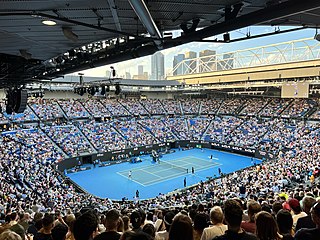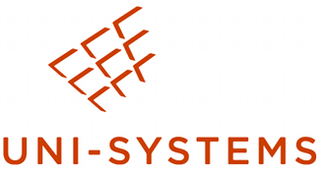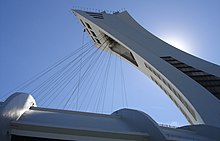
A tennis court is the venue where the sport of tennis is played. It is a firm rectangular surface with a low net stretched across the centre. The same surface can be used to play both doubles and singles matches. A variety of surfaces can be used to create a tennis court, each with its own characteristics which affect the playing style of the game.

Rogers Centre is a retractable roof stadium in Downtown Toronto, Ontario, Canada, situated at the base of the CN Tower near the northern shore of Lake Ontario. Opened in 1989 on the former Railway Lands, it is home to the Toronto Blue Jays of Major League Baseball (MLB). Previously, the stadium was also home to the Toronto Argonauts of the Canadian Football League (CFL) and the Toronto Raptors of the National Basketball Association (NBA). The Buffalo Bills of the National Football League (NFL) played an annual game at the stadium as part of the Bills Toronto Series from 2008 to 2013. While it is primarily a sports venue, it also hosts other large events such as conventions, trade fairs, concerts, travelling carnivals, circuses and monster truck shows.

Arena AufSchalke, currently known as Veltins-Arena for sponsorship reasons, is a retractable roof football stadium in Gelsenkirchen, North Rhine-Westphalia, Germany. It opened on 13 August 2001, as the new home ground for FC Schalke 04.

Melbourne Park is a sports venue in the Melbourne Sports and Entertainment Precinct in Melbourne, Victoria, Australia. Since 1988, Australia's bicentenary, Melbourne Park has been home of the Australian Open Grand Slam tennis tournament played annually in January. The park has multiple venues where the Australian Open matches take place. Rod Laver Arena is the largest venue with a capacity of 15,000, while John Cain Arena seats 10,500 and Margaret Court Arena 7,500. The three venues feature retractable roofs, allowing events to be played indoors or outdoors. Besides, there is the Show Court 3 and 1573 Arena which both have a 3,000 seating capacity, and the new 5000-seat Kia Arena. In total there are 35 outdoor Greenset tennis courts at Melbourne Park.

Arthur Ashe Stadium is a tennis arena at Flushing Meadows–Corona Park in Queens, New York City. Part of the USTA Billie Jean King National Tennis Center, it is the main stadium of the US Open tennis tournament and has a capacity of 23,771, making it the largest tennis stadium in the world.

The Melbourne Sports and Entertainment Precinct is a series of sports stadiums and venues, located in Melbourne, Victoria, in Australia. The precinct is situated around 3 km east of the Melbourne central business district, located in suburbs of Melbourne and Jolimont, near East Melbourne and Richmond.
The 50th Grey Cup, also nicknamed the Fog Bowl, was the 1962 Grey Cup Canadian Football League championship game played between the Winnipeg Blue Bombers and the Hamilton Tiger-Cats on December 1, 1962, at Toronto's Exhibition Stadium. It remains the only Grey Cup game ever suspended during play, and the first to be finished on a Sunday. The Grey Cup was won by the Blue Bombers with the score of 28–27 in 1962 and it's still considered to be one of the ten best Grey Cup games of all time.

Rod Laver Arena is a multipurpose arena located within Melbourne Park, in Melbourne, Victoria, Australia. The arena is the main venue for the Australian Open, the first Grand Slam tennis tournament of the calendar year.

Sapporo Dome is a stadium located in Sapporo, Hokkaido, Japan, and is primarily used for association football. It is the home field of the association football club Hokkaido Consadole Sapporo, and was also home to the baseball team Hokkaido Nippon-Ham Fighters through the 2022 Nippon Professional Baseball season. It was a football venue for the 2020 Summer Olympics, was the venue for the opening ceremony of the 2017 Asian Winter Games, and was used for two matches of the 2019 Rugby World Cup. The stadium also hosted matches during the 2002 FIFA World Cup.

A ballpark, or baseball park, is a type of sports venue where baseball is played. The playing field is divided into two field sections called the infield and the outfield. The infield is an area whose dimensions are rigidly defined in part based on the placement of bases, and the outfield is where dimensions can vary widely from ballpark to ballpark. A larger ballpark may also be called a baseball stadium because it shares characteristics of other stadiums.

The Qizhong Forest Sports City Arena (上海旗忠森林体育城网球中心), also known as Qizhong Stadium, is a tennis arena in Shanghai, People's Republic of China. The complex is located on an 80-hectare (200-acre) area, in Maqiao Town, in the southwest of Shanghai, Minhang District. It has a steel retractable roof which opens and closes in a pinwheel or spiral manner, with eight sliding petal-shaped pieces resembling a blooming magnolia. The roof enables the stadium to host both indoor and outdoor tennis events. The seating capacity is 13,779 people.

A multi-purpose stadium is a type of stadium designed to be easily used for multiple types of events. While any stadium could potentially host more than one type of sport or event, this concept usually refers to a specific design philosophy that stresses multifunctionality over specificity. It is used most commonly in Canada and the United States, where the two most popular outdoor team sports—Canadian football or American football and baseball—require radically different facilities. Football uses a rectangular field, while baseball is played on a diamond with a large outfield. Since Canadian football fields are larger than American ones, the design specifications for Canadian facilities are somewhat less demanding. The particular design to accommodate both is usually an oval, although some later designs use an octorad. While building stadiums in this way means that sports teams and governments can share costs, it also presents some challenges.

The Stadion Narodowy im. Kazimierza Górskiego, known for sponsorship reasons as the PGE Narodowy since 2015, is a retractable roof football stadium located in Warsaw, Poland. It is used mostly for concerts and football matches and is the home stadium of Poland national football team.

Uni-Systems, LLC is a design, construction, and manufacturing firm located in Minneapolis, Minnesota specializing in kinetic architecture, or movable, mechanized structures. Uni-Systems has been involved in the construction of five of the seven sports stadiums incorporating retractable roofs in North America since 1999.
Geiger Engineers is the doing business name of Geiger Lynch MacBain Campbell Engineers, P.C., an American structural engineering consulting firm located northwest of New York City. Founded in 1988 by David H. Geiger, Paul A. Gossen, Kris P. Hamilton, David D. Chen, David M. Campbell, and Mike Liao, the company has worked on large projects throughout the world. Starting from long span and tensile membrane structures, Geiger Engineers has branched out over the years into a range of specialties from designing sports facilities to providing engineering services for the entertainment industry.

A skylight is a light-permitting structure or window, usually made of transparent or translucent glass, that forms all or part of the roof space of a building for daylighting and ventilation purposes.

Mercedes-Benz Stadium is a multi-purpose stadium located in Atlanta, Georgia, United States. Opened in August 2017 as a replacement for the Georgia Dome, it serves as the home stadium of the Atlanta Falcons of the National Football League (NFL) and Atlanta United FC of Major League Soccer (MLS). The stadium is owned by the state government of Georgia through the Georgia World Congress Center Authority, and operated by AMB Group, the parent organization of the Falcons and Atlanta United FC. In June 2016, the total cost of its construction was estimated at US$1.6 billion.

The 2014 NHL Heritage Classic was an outdoor regular season National Hockey League (NHL) game held indoor, part of the Heritage Classic series of outdoor NHL ice hockey games in Canada. It took place on March 2, 2014, in BC Place in Vancouver, with the Ottawa Senators facing off against the home team Canucks. It is the first "outdoor" game to be played in what technically is an indoor stadium, albeit one of a larger capacity than a typical NHL arena; BC Place is a retractable roof venue, and it is unknown if the stadium has the capabilities to keep its roof open during inclement weather. The game was televised nationally in Canada on CBC and nationally in the United States on NBCSN.






















